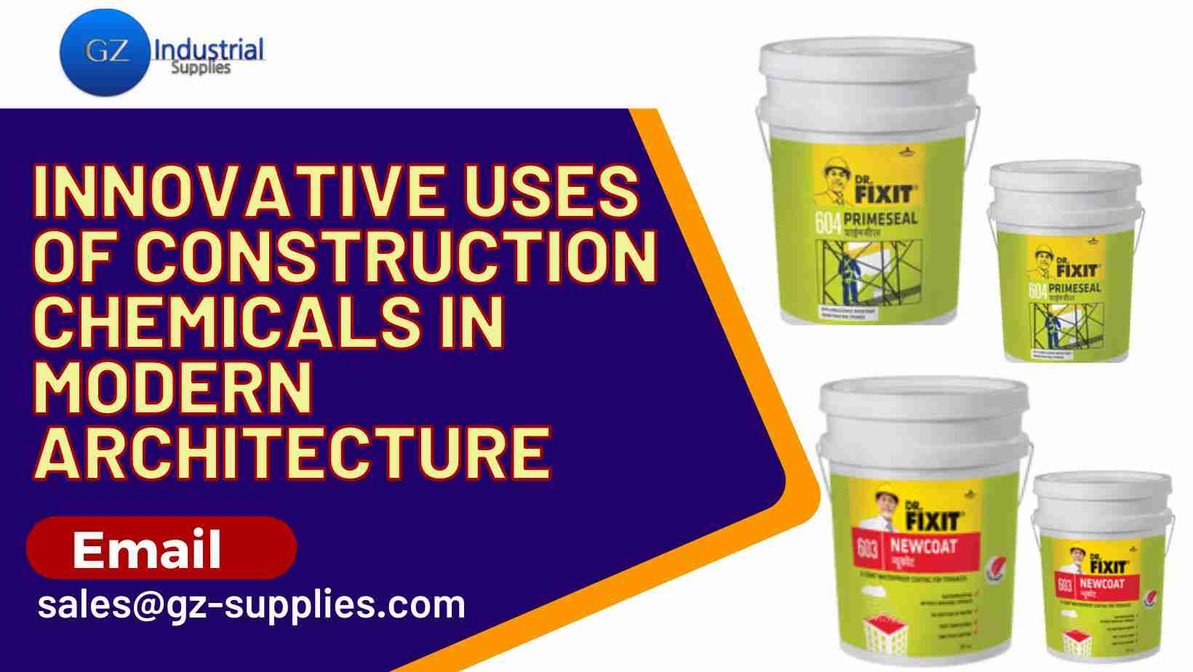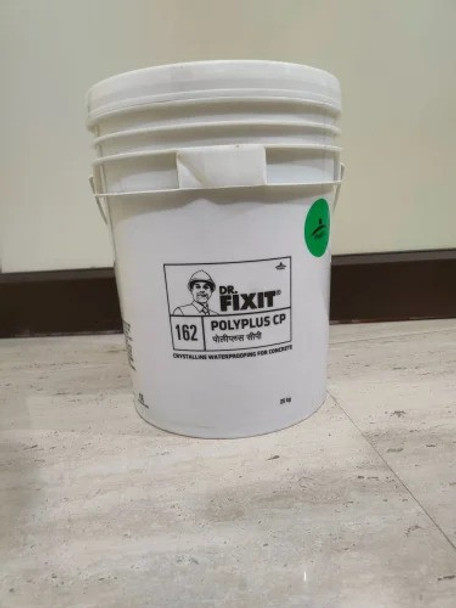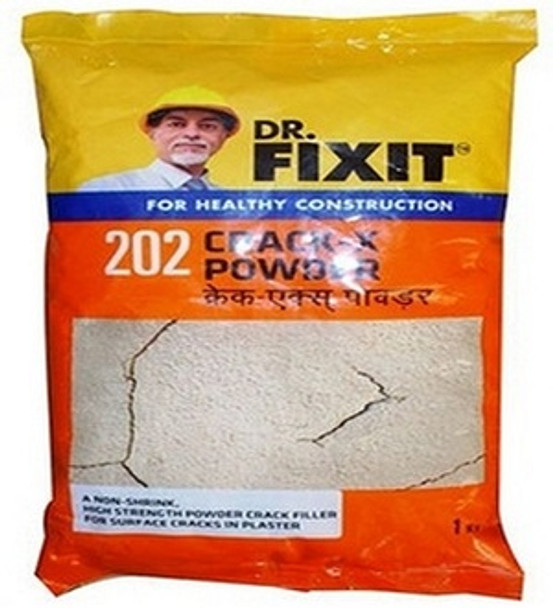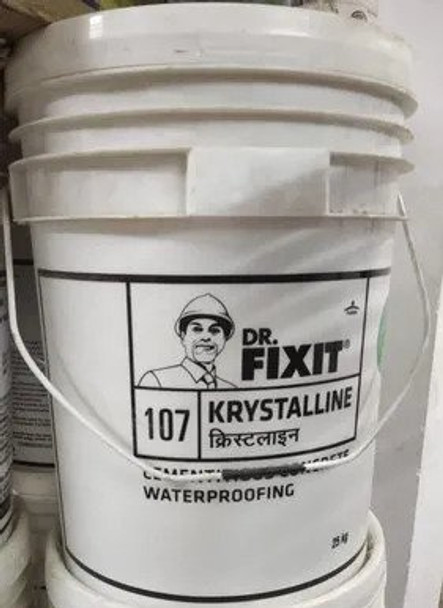Innovative Uses of Construction Chemicals in Modern Architecture
Construction chemicals are essential compounds used in building structures, with polymers being one of the most common materials used. These chemicals serve various purposes, including speeding up construction projects, enhancing strength, and increasing durability. They are mixed into construction materials like flooring, sealants, admixtures, and waterproofing agents to improve productivity, performance, and functionality while safeguarding building components.
These chemicals make an integral part when it comes to building complex constructions and have even found applications in different construction projects for enhancing the construction materials, and quality, along with offering longevity and sustainability. Today, construction chemicals encompass a wide range of products, from flooring chemicals to maintenance and repair solutions. They have become integral to construction projects, enhancing performance, durability, and sustainability. Recent years have seen significant innovations in this field, revolutionizing how we construct and maintain buildings.
In this article, we will delve into the transformative impact of innovative construction chemicals in modern architecture. We will highlight their crucial role in shaping the built environment of the future.
Buy Online...Dr. Fixit Polyplus CP - The ultimate waterproofing and sealing solution for concrete.
Utilizing Construction Chemicals for Structural Strength
Construction chemicals play a pivotal role in modern architecture, particularly in enhancing the structural strength of buildings. Here’s how they contribute to reinforcing concrete structures and enhancing durability:
Reinforcing Concrete Structures
Construction chemicals such as concrete admixtures are integral in improving the performance of concrete. These admixtures are added during the mixing process to achieve various enhancements:
- Water-reducing admixtures help in reducing the water content in concrete, leading to higher strength and reduced permeability.
- Superplasticizers allow for the reduction of water without compromising workability, which is essential for complex forms and shapes.
- Accelerators speed up the curing process, beneficial in time-sensitive projects or in colder climates where concrete might set more slowly.
- Fibers can be mixed into the concrete to provide additional reinforcement, reducing the risk of cracking and increasing tensile strength.
- Epoxy Resins are employed in instances where concrete structures exhibit cracks or voids. They are used to fill these imperfections, and their excellent adhesive properties enable them to bond effectively with concrete surfaces, restoring structural integrity and preventing further deterioration.
Enhancing Durability and Longevity
The longevity of a structure is directly linked to the quality of materials used and their resistance to environmental factors. Construction chemicals enhance durability by:
- Protecting against corrosion: Corrosion inhibitors are used to protect steel reinforcements within concrete from rusting, which is crucial in maintaining structural integrity.
- Sealing and waterproofing: Chemical sealants fill in pores and micro-cracks, preventing water ingress that can lead to structural damage over time. Thereby extending the service life of the structure.
- Resistance to chemicals: Certain admixtures provide resistance against aggressive substances, which is particularly important in industrial settings where exposure to harsh chemicals is common.
By integrating these construction chemicals, architects and engineers can ensure that the structures not only meet the required strength parameters but also stand the test of time. The use of these chemicals is a testament to the innovative approaches in modern architecture that prioritize both aesthetics and functionality.
Buy Online… Dr. Fixit 302 Super Latex” - The very best to bond, waterproof, and repair your concrete structures.
Improving Aesthetics with Construction Chemicals
In modern architecture, aesthetics play a crucial role in shaping the visual appeal and identity of buildings. Construction chemicals offer a myriad of solutions to enhance aesthetics, ranging from architectural finishes to colour enhancement and protection. Let's explore how these chemicals contribute to the visual aesthetics of buildings:
Architectural Finishes and Coatings
Architectural finishes and coatings serve as the interface between the environment and the structural elements, providing both protection and an enhanced visual appeal. Construction chemicals are crucial in this aspect:
- Epoxy and polyurethane coatings offer a high-gloss finish that can transform the look of floors and walls, making them not only durable but also aesthetically pleasing.
- Acrylic coatings provide a weather-resistant finish that can be tinted to match any design palette, ensuring that the building’s appearance remains vibrant over time.
- Texture coatings, also known as decorative coatings, are applied to exterior and interior surfaces to add depth, dimension, and tactile appeal. These coatings are formulated with additives such as aggregates, polymers, and pigments to create a wide range of finishes, including stucco, stone, brick, and metallic effects.
- Protective coatings serve to safeguard building surfaces from environmental factors such as UV radiation, moisture, pollutants, and abrasion. These coatings form a durable barrier that shields the structure, prolonging its lifespan and maintaining its visual integrity over time.
- Anti-Graffiti coatings offer a practical solution to protect buildings from defacement. These coatings form a sacrificial barrier that allows graffiti to be easily removed without damaging the underlying surface.
Colour Enhancement and Protection
Colour plays a pivotal role in defining the visual identity and character of architectural elements. Construction chemicals are instrumental in enhancing and preserving the vibrancy and longevity of colours used in building materials through the following means:
- Pigment Dispersions: Construction chemicals include pigment dispersions specifically formulated for use in paints, coatings, and concrete admixtures. These dispersions ensure uniform colour distribution, vibrant hues, and long-lasting colour retention, enhancing the visual impact of architectural elements.
- UV Stable Coatings: Ultraviolet (UV) radiation from sunlight can cause fading and discoloration of building materials over time. UV stable coatings, containing additives such as UV absorbers and stabilizers, protect surfaces from UV-induced degradation, ensuring colour retention and preserving the aesthetic integrity of the structure.
- Weatherproof Sealants: Exterior surfaces exposed to the elements require weatherproof sealants to prevent moisture ingress and colour fading. Construction chemicals offer a range of weatherproof sealants that provide durable protection against water penetration, UV radiation, and environmental pollutants, thereby maintaining the vividness of colours and extending the lifespan of architectural finishes.
Buy Online... Epochem Polyurethane Floor Paint:- Experience top notch floor protection with a glossy finish that resists everything from scratches to high temperatures!
Environmental Considerations in Construction Chemicals
The integration of environmental considerations into the selection and use of construction chemicals is a testament to the industry’s commitment to sustainability. Here’s how these chemicals are being used to promote eco-friendliness and minimize environmental impact:
Sustainable and Eco-Friendly Options
The push for sustainability in construction has led to the development of eco-friendly chemicals that serve the dual purpose of performance and environmental responsibility:
- Bio-based admixtures: These are derived from renewable resources and reduce the carbon footprint associated with construction.
- Low-VOC (Volatile Organic Compounds) compounds: By using low-VOC sealants and adhesives, buildings contribute less to air pollution and improve indoor air quality.
- Recycled materials: Some construction chemicals are now made using recycled waste materials, which helps in reducing landfill waste and promoting a circular economy.
- Energy-efficient Production Processes: Some construction chemical manufacturers implement energy-efficient production processes and utilize renewable energy sources to minimize carbon emissions and reduce energy consumption.
Minimizing Environmental Impact
Reducing the environmental impact of construction activities is a critical aspect of modern architecture. Construction chemicals aid in this endeavor by:
- Water-based technologies: These reduce the reliance on solvents that can harm the environment and are easier to clean, reducing water pollution.
- Energy-efficient solutions: Thermal insulating coatings and reflective surfaces contribute to energy conservation, lessening the overall environmental impact of buildings.
- Sustainable packaging and dispensing: Manufacturers are increasingly focusing on reducing waste by offering construction chemicals in sustainable packaging and efficient dispensing systems.
- Life Cycle Assessment (LCA): Manufacturers conduct life cycle assessments to evaluate the environmental impact of construction chemicals throughout their entire life cycle, from raw material extraction to disposal. By quantifying environmental impacts, manufacturers can identify opportunities for improvement and develop more sustainable products and processes.
Buy Online… Dr. Fixit 202 Crack-X Powder- Say goodbye to unsightly cracks and hello to perfectly smooth finish before painting.
Regulatory Compliance and Safety Measures
In the construction industry, adherence to industry standards and regulations is paramount to ensuring the safety of workers, occupants, and the environment. Construction chemicals are subject to stringent regulatory requirements, and implementing safety measures is essential to mitigate potential risks. Here’s how construction chemicals are managed to ensure safety and compliance:
Adhering to Industry Standards and Regulations
Construction chemicals are subject to stringent industry standards and regulations to ensure that they meet safety and performance criteria:
- Compliance with Regulatory Requirements: Manufacturers of construction chemicals must comply with a range of industry standards and regulations set by bodies such as the Standards Organization of Nigeria (SON) and the National Environmental Standards and Regulations Enforcement Agency (NESREA). These regulations ensure that products meet quality standards, safeguard human health, and protect the environment.
- Product Certification and Testing: Construction chemicals undergo thorough testing and certification processes to verify compliance with applicable industry standards and regulatory requirements. Certifications such as the Nigerian Industrial Standard (NIS) and the Nigerian Quality Mark (NQM) indicate adherence to established quality and safety standards, providing assurance to consumers and project stakeholders.
- Material Safety Data Sheets (MSDS): Manufacturers provide Material Safety Data Sheets (MSDS) or Safety Data Sheets (SDS) for construction chemicals, containing essential information on chemical composition, hazards, handling precautions, and emergency response procedures. MSDS/SDS enable users to assess risks associated with the chemicals and implement appropriate safety measures during handling, storage, and disposal.
- Environmental Impact Assessments: In projects affecting the environment, environmental impact assessments are conducted to evaluate the potential effects of construction chemicals on ecosystems, water quality, and air quality. These assessments inform decision-making and help implement mitigation measures to minimize adverse environmental impacts.
Ensuring Safe Handling and Application of Construction Chemicals
The safe handling and application of construction chemicals are critical to prevent accidents and health hazards:
- Training: Workers handling these chemicals must receive proper training on their safe use, including understanding Material Safety Data Sheets (MSDS) which provide information on handling, hazards, and emergency measures.
- Personal Protective Equipment (PPE): Appropriate PPE such as gloves, masks, and goggles must be worn to protect against chemical exposure.
- Storage and disposal: Chemicals must be stored in conditions that prevent degradation or dangerous reactions and disposed of in accordance with environmental regulations to prevent contamination.
- Ventilation and Engineering Controls: Adequate ventilation systems and engineering controls are installed to minimize exposure to hazardous fumes, dust, and vapors generated during the application of construction chemicals.
- Emergency Response Planning: Employers should develop and implement emergency response plans to address potential spills, leaks, or accidental exposures to construction chemicals. These plans outline procedures for containment, cleanup, decontamination, and reporting incidents, as well as protocols for providing medical assistance to affected individuals.
Buy Online… Dr. Fixit Krystalline 107 - Experience the power of proactive waterproofing and corrosion protection.
Related article
The Evolution of Construction Chemicals: Past, Present, and Future
Conclusion
In the dynamic landscape of modern architecture, the utilization of construction chemicals emerges as a cornerstone for innovation, sustainability, and safety. Throughout this article, we've discussed how these chemicals contribute to structural strength, enhance aesthetics, consider environmental impact, and adhere to regulatory compliance and safety measures. From reinforcing concrete structures to creating captivating architectural finishes, construction chemicals offer a diverse array of solutions that empower architects, engineers, and builders to realize their creative vision while ensuring structural integrity and longevity. Moreover, the integration of sustainable and eco-friendly options underscores a commitment to environmental stewardship, promoting healthier built environments and minimizing ecological footprints.
Also, amidst the pursuit of innovation, safety remains paramount. By adhering to industry standards, providing comprehensive training, and implementing robust safety protocols, stakeholders in the construction industry can mitigate risks associated with the handling and application of construction chemicals, safeguarding the well-being of workers, occupants, and the environment. For more information or enquiries please do well to Contact Us Today.
Recent Posts
-
Why Serious Mechanics Are Switching to Japanese-Made Shinano Air Tools
Japanese-Made Shinano Air Tools Key takeaway: Shinano’s tight-tolerance, twin-hammer designs d …Apr 24, 2025 -
Top 10 Hand Tool Brands for Professionals
Introduction When it comes to professional hand tools, quality, durability, and reliability are para …Apr 23, 2025 -
HOW DOES CORROSION INHIBITOR WORK
Introduction Corrosion has posed a lot of problems to various companies and industries; by interfer …Apr 22, 2025








